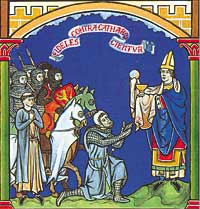The Pretext
After the failure of all verbal arguments, Rome raised the stakes and began seizing and burning self-confessed Cathars wherever they could be found. However, in Languedoc they were not that easy to arrest. The ‘perfecti’ were loved and protected by all classes of society and were able to continue their preaching undeterred.
Then the Pope adopted another tactic. He began excommunicating all those barons who dared to offer the Cathars hospitality. This proved more effective, but it aroused so much anger that, in the winter of 1208, an eminent legate, who had been excommunicating southern nobles with reckless enthusiasm, was assassinated on his way back to Rome.

The Murder of Peter of Castelnau 1208
‘When day dawned these virtuous cavaliers of Christ were preparing to cross the river, when a disciple of Satan brandishing a lance, struck Pierre from behind. Leaning on the strength of Christ, he turned piously to his impious attacker saying, ‘As God forgives, I forgive you also. Then he fell asleep blessed in the Lord.’
Pierre des Vaux-de-Cernay
Pope Innocent affected deep shock at the murder, but it was just the pretext he needed to launch a campaign of terror and extermination against both the Cathars and the disaffected nobility of Languedoc.
At once Count Raymond VI of Toulouse was singled out as the guilty party and a holy crusade was declared to rid his domains of the hated Cathars. By a typically high-handed papal decree all land owned by heretics could be confiscated at will and as Languedoc was full of Cathar sympathisers, this was an open invitation to wholesale theft with the blessings of the Church. The rich fiefs of Languedoc could be pillaged with a clear conscience. It is little wonder that the barons of the north flocked south to do battle for the honour of the Church.
Previous crusades to recover the Holy Land had always been launched by the Church of Rome, but at least those crusaders had confronted an alien religion and been fired with a genuine religious enthusiasm. This new crusade was a mockery of the term. Its declared intention was the dispossession and murder of other Christians simply because they disagreed with the Rome.

Summons to Crusade
‘The Sovereign Pontiff had circulars published throughout France, announcing that God would forgive the sins of everyone who took up arms to avenge this insult to the Cross.’
Pierre des Vaux-de-Cernay
Several Church leaders joined the growing army, each leading a mixed group of soldiers and misguided pilgrims. Despite the loud exhortations to avenge the honour of God, the bulk of the self-righteous host that rallied to the banner in 1209 were motivated as much by the prospect of unlimited plunder and the acquisition of valuable real estate as they were for the well being of the Church.
By early summer a great army had assembled at Lyons. In its unholy appetite for a total monopoly of power, the Church had created a monster of murder and destruction. Now its dreadful creation turned southwards and lumbered off down the Rhone valley towards Languedoc. At its head rode Arnald-Amalric, the fanatical Abbot of Citeaux.
This is an extract from ‘Cathar Eclipse’ by Forrester Roberts.
With more than fifty illustrations the book is thoroughly readable in its own right, but also makes an admirable companion to the Spirit of Crusade map. At this time it is printed by computer in English only. A French version is being prepared.
Either version can be bought.